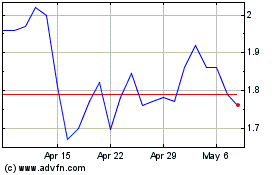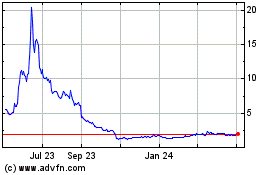Sonnet BioTherapeutics Holdings, Inc. (the “Company” or “Sonnet”)
(NASDAQ:SONN), a clinical-stage company developing targeted
immunotherapeutic drugs, today announced encouraging data from the
Phase 1b portion of its Phase 1b/2a clinical trial evaluating
SON-080 for the treatment of CIPN (the “SB211 study”). The SB211
study is a double-blind, randomized, controlled trial of SON-080
conducted at two sites in Australia in patients with persistent
CIPN using a new proprietary version of recombinant human
Interleukin-6 (rhIL-6) that builds upon previous work with atexakin
alfa. The goal of the Phase 1b portion of the SB211 study was to
confirm safety and tolerability before continued development in
Phase 2. As previously announced in March 2024, a data and safety
monitoring board reviewed the unblinded safety and tolerability of
SON-080 in the first nine patients and concluded that the symptoms
were tolerable in the initial patients and the study could proceed
to Phase 2. Additionally, the Company participated in a Virtual
Investor “What This Means” segment to further discuss the Phase 1b
data and highlight what this means for its development program
moving forward. Click here to access the segment.
CIPN is a common side effect of many
chemotherapeutic drugs that induce peripheral nerve damage. CIPN
can last for weeks to years after treatment has ended and patients
with CIPN often experience discomfort that can result in
persistent, unbearable pain, as well as motor and autonomic
dysfunction that may limit the duration of their cancer treatment.
Conventional pain medications and opioids are often ineffective
against peripheral neuropathy, creating a significant unmet need
for new treatment options. Low dose IL-6 has been shown to
stimulate peripheral nerve growth in preclinical models, thereby
ameliorating motor and sensory functions and normalizing the
associated pain or sensation disturbance of neuropathy.
“We believe this highly encouraging data bridges
the large atexakin alfa historical safety database in cancer
patients and is foundational in advancing the development of
SON-080 to a Phase 2 study evaluating the neuroprotective and
neuro-regenerative effects in DPN,” said Pankaj Mohan, Ph.D.,
Sonnet Founder and Chief Executive Officer. “IL-6 is often
dysregulated in diabetic patients, suggesting there is disease
modifying potential for the application of rhIL-6 in DPN. Given the
high prevalence of neuropathy in diabetes and the commensurate
industry interest in this market, we have prioritized DPN as the
best potential indication for Phase 2 development. We intend to
seek a partnership to move the asset forward towards
commercialization."
A total of 9 patients were randomized between
two different SON-080 dose groups and placebo in this portion of
the study. The treatment period was 12 weeks long and patients were
followed-up for an additional 12 weeks.
The Phase 1b data demonstrated SON-080 was
well-tolerated at both 20 µg and 60 µg/dose, which was about
10-fold lower than the maximum tolerated dose (MTD) for IL-6 that
was established in previous clinical evaluations. Injection site
erythema was the most prominent treatment-related adverse event
irrespective of the dose of SON-080, and was transient and mild in
all but one case at each dose, where it was moderate. Fatigue was
reported occasionally and was more prominent at the higher dose.
One patient who developed severe fatigue and stopped dosing after
one month was in the low-dose group. Headache, dizziness, and
chills were reported infrequently in the high-dose group; all were
mild apart from a single moderate event with each symptom. All
other adverse events were infrequent and mild.
"These data suggest possible benefits in humans
with various types of peripheral neuropathy due to cancer and
diabetes. Interleukin-6 has been extensively studied in cancer
patients in the past, so the use of SON-080 in CIPN was expected to
provide a similar adverse event profile at low doses," commented
Richard Kenney, M.D., Sonnet's Chief Medical Officer. "We now have
a further understanding of the adverse event profile and the
opportunity to look at preliminary efficacy trends. We look forward
to initiating a Phase 2 study with a partner in the much
larger DPN indication."
The Quality-of-Life Questionnaire-CIPN
twenty-item scale (QLQ-CIPN20), a validated survey designed to
assess cancer patients’ experience of symptoms and functional
limitations related to CIPN, was used as the primary indicator of
response. While the number of patients in each group was small, a
trend toward improved scores within a month of starting therapy was
seen for both dose groups as compared to placebo in the overall
scores. This greater improvement with SON-080 persisted after the
12 weeks of therapy had stopped, while the placebo group scores
returned to baseline. These results are in line with the
preclinical model insights with low dose IL-6, although further
work with larger clinical groups is needed to substantiate this
trend.
Multiple cytokines were studied as part of the
safety evaluation. There was no demonstrable drug effect on any of
these inflammatory cytokine serum levels during or after therapy
with SON-080. However, there was a dose-related increase in serum
amyloid alpha that persisted during therapy, which returned to
baseline once treatment was stopped. An expert consultant concluded
that the degree of amyloid elevation seen in this study for 12
weeks should be benign.
For more information about the SB211 study,
visit clinicaltrials.gov and reference identifier NCT05435742.
About SON-080 as a Therapeutic Drug
Candidate
SB211 studied a low dose of rhIL-6 called
SON-080 that has an amino acid sequence identical to the native
molecule. The trial targets serum levels similar to those induced
with moderate exercise, which triggers the natural healing of
nerves, muscle, and bone. As a pleiotropic cytokine, native IL-6
participates in several physiological processes, including tissue
repair, glucose homeostasis, and the innate immune response at
lower levels, but it can result in acute pathological inflammation
at higher serum levels. Preclinical models of CIPN and DPN show
that low dose rhIL-6 has the potential to stimulate nerve regrowth
to re-establish normal sensations, thereby reducing pain and
normalizing some of the physiological conditions that had
deteriorated due to nerve degeneration. Early versions of rhIL-6,
including Serono’s atexakin alfa and others, have been tested in
hundreds of patients with cancer, diabetes, idiopathic aplastic
anemia, and in healthy controls, showing a maximum tolerated dose
of 10 µg/kg three times a week (TIW). The IL-6-related fever,
nausea, and vomiting that were prominent adverse events at doses
over 2.5 µg/kg TIW were substantially reduced at lower
doses.
About the
SB211 Phase
1b/2a Trial
The SB211 study was primarily designed to
evaluate the safety, PK, PD, and initial efficacy of two dose
levels of SON-080 compared to placebo. The drug is
self-administered subcutaneously three times a week in patients
with CIPN lasting at least 3 months after chemotherapy. The study
was conducted at multiple sites in Australia, in a blinded fashion,
comparing SON-080 to placebo. The primary endpoint explores the
safety and tolerability of SON-080, with key secondary endpoints
intended to measure PK, PD, and immunogenicity. Preliminary
efficacy is being explored using standardized quality of life and
pain questionnaires over the course of the trial.
About Sonnet BioTherapeutics Holdings, Inc.
Sonnet BioTherapeutics is an oncology-focused
biotechnology company with a proprietary platform for innovating
biologic drugs of single or bifunctional action. Known as FHAB
(Fully Human Albumin Binding), the technology utilizes a fully
human single chain antibody fragment (scFv) that binds to and
"hitch-hikes" on human serum albumin (HSA) for transport to target
tissues. Sonnet's FHAB was designed to specifically target tumor
and lymphatic tissue, with an improved therapeutic window for
optimizing the safety and efficacy of immune modulating biologic
drugs. FHAB is the foundation of a modular, plug-and-play construct
for potentiating a range of large molecule therapeutic classes,
including cytokines, peptides, antibodies, and vaccines.
Forward-Looking Statements
This press release contains certain
forward-looking statements within the meaning of Section 27A of the
Securities Act of 1933 and Section21E of the Securities Exchange
Act of 1934 and Private Securities Litigation Reform Act, as
amended, including those relating to the Company's cash runway, the
Company's product development, clinical and regulatory timelines,
market opportunity, competitive position, possible or assumed
future results of operations, business strategies, potential growth
opportunities and other statements that are predictive in nature.
These forward-looking statements are based on current expectations,
estimates, forecasts and projections about the industry and markets
in which we operate and management's current beliefs and
assumptions.
These statements may be identified by the use of
forward-looking expressions, including, but not limited to,
"expect," "anticipate," "intend," "plan," "believe," "estimate,"
"potential," "predict," "project," "should," "would" and similar
expressions and the negatives of those terms. These statements
relate to future events or our financial performance and involve
known and unknown risks, uncertainties, and other factors which may
cause actual results, performance or achievements to be materially
different from any future results, performance or achievements
expressed or implied by the forward-looking statements. Such
factors include those set forth in the Company's filings with the
Securities and Exchange Commission. Prospective investors are
cautioned not to place undue reliance on such forward-looking
statements, which speak only as of the date of this press release.
The Company undertakes no obligation to publicly update any
forward-looking statement, whether as a result of new information,
future events or otherwise.
Investor Relations Contact:JTC Team, LLCJenene
Thomas 833-475-8247SONN@jtcir.com
SOURCE: Sonnet BioTherapeutics, Inc.
Sonnet BioTherapeutics (NASDAQ:SONN)
Historical Stock Chart
From Dec 2024 to Jan 2025

Sonnet BioTherapeutics (NASDAQ:SONN)
Historical Stock Chart
From Jan 2024 to Jan 2025
